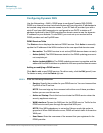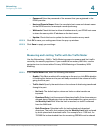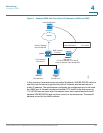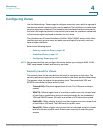
Networking
Configuring a VLAN
Cisco ISA500 Series Integrated Security Appliances Administration Guide 139
4
STEP 3 In the DHCP Pool Settings tab, choose the DHCP mode from the DHCP Mode
drop-down list.
• Disable: Choose this option if the computers on the VLAN are configured
with static IP addresses or are configured to use another DHCP server.
• DHCP Server: Allows the security appliance to act as a DHCP server and
assigns IP addresses to all devices that are connected to the VLAN. Any new
DHCP client joining the VLAN is assigned an IP address of the DHCP pool.
• DHCP Relay: Allows the security appliance to use a DHCP Relay. If you
choose DHCP Relay, enter the IP address of the remote DHCP server in the
Relay IP field.
STEP 4 If you choose DHCP Server as the DHCP mode, enter the following information:
• Start IP: Enter the starting IP address of the DHCP pool.
• End IP: Enter the ending IP address of the DHCP pool.
NOTE: The Start IP address and End IP address should be in the same
subnet with the VLAN IP address.
• Lease Time: Enter the maximum connection time that a dynamic IP address
is “leased” to a network user. When the time elapses, the user will be
automatically renewed the dynamic IP address.
• DNS1: Enter the IP address of the primary DNS server.
• DNS2: Optionally, enter the IP address of the secondary DNS server.
• WINS1: Optionally, enter the IP address of the primary WINS server.
• WINS2: Optionally, enter the IP address of the secondary WINS server.
• Domain Name: Optionally, enter the domain name for the VLAN.
• Default Gateway: Enter the IP address for default gateway.
• Option 66: Provides provisioning server address information to hosts
requesting this option. Only supports the IP address or host name of a single
TFTP server. Enter the IP address of the single TFTP server for the VLAN.
• Option 67: Provides a configuration/bootstrap file name to the hosts
requesting this option. This is used in conjunction with the option 66 to allow
the client to form an appropriate TFTP request for the file. Enter the
configuration/bootstrap file name on the specified TFTP server.


















